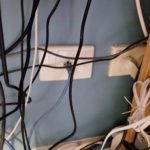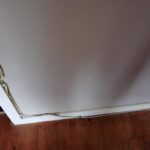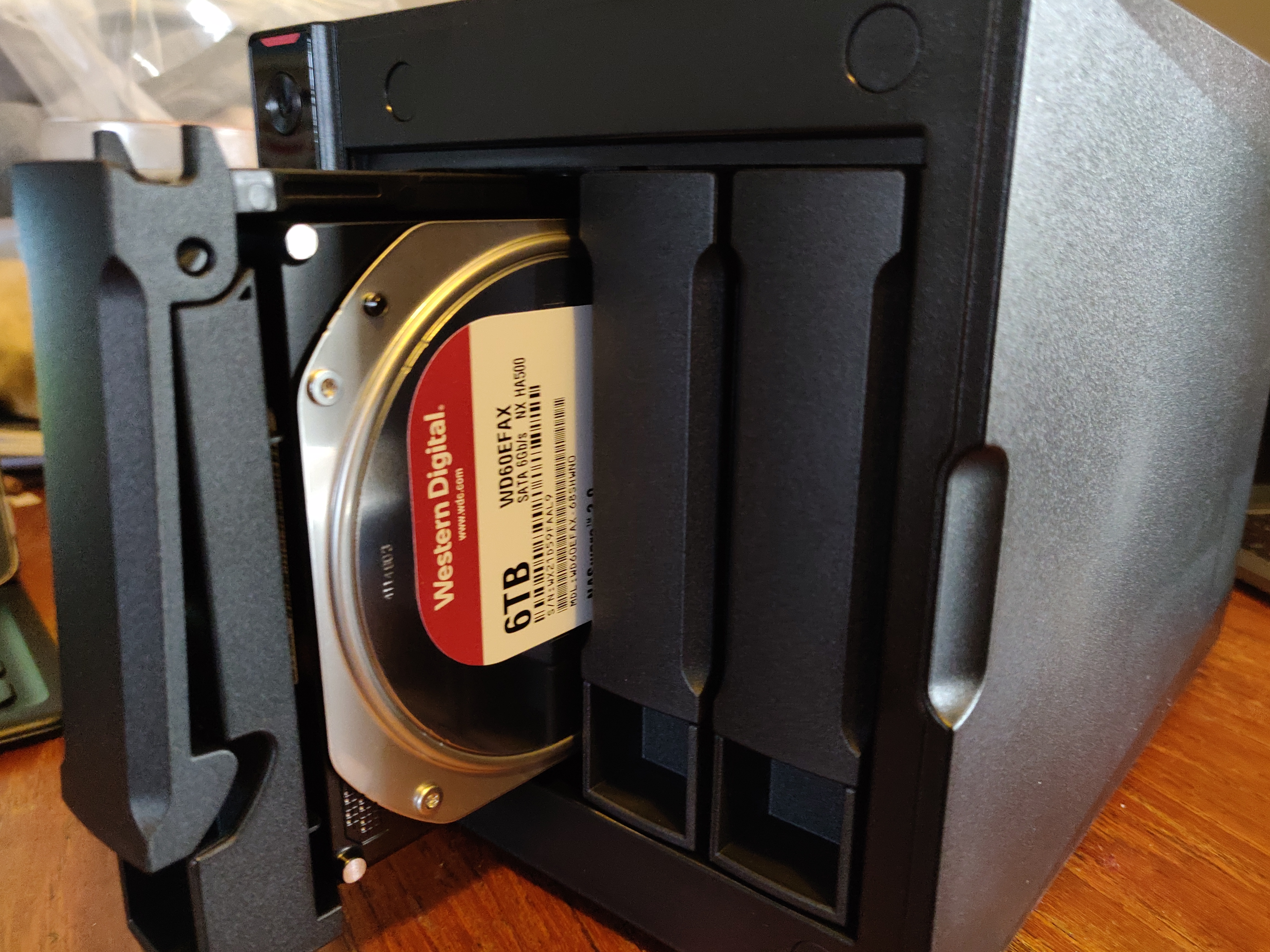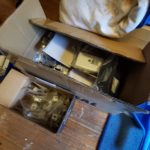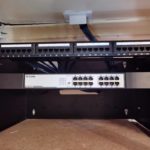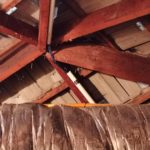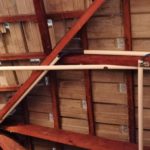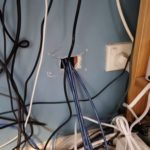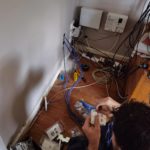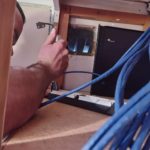I’ve been in my house with my wife for about 15 years now and life has changed a lot in that time. When we first got ADSL2, we had Ethernet cables running down the hallway into the living area to provide our DVR with connectivity. Then one of the bedrooms became a bit of a geeks lair, networked well and upgraded to a WiMax connection which required some networking through the house – my first mistake!
Because of a few factors, primarily available time, I did a quick and dirty (read cheap) job of the wiring. With a single network port in the living room, a single port in the spare bedroom a single port in the master bedroom and a 4 port wall panel in the lair. These four ports connected to the other ports mentioned and the 4th went to the WiMax dish on the roof. Over time little bits have been added to the network for extra hardware that required connectivity and it’s bitten me in the ass more than once.
At the time I wasn’t really thinking about future-proofing the system, possibly because kids weren’t on the radar at the time. Roll forward a few years, things 1 and 2 had arrived and the lair became my daughter’s bedroom. Not really a problem, but it’s added some clumsiness and complexity to the network, it’s also meant that she’s disconnected me more than once…
Now my PC (as well as some other hardware) in the master bedroom connects to the router, through a switch that goes via the cable into my daughter’s room, which goes through the roof to the living room and a long cable over the doorframe and the franken-network was born. It’s been OK for a number of years, but with recent changes and my kids getting older it’s very soon going to become an issue for me and it’s time to take action.
Planning the layout and thinking about growth
One of the major factors that drove the decision to finally clean up the network was the fact that we’ve recently pulled the trigger on a solar battery for our home. This requires a permanent, ethernet-based internet connection and frankly… my router is full. So it was time to make a change and plan for the future of my home network, even going overkill to make sure I don’t need to do it again anytime soon.
I had to start by thinking about connectivity around the home and what I may need in the future. The master bedroom where my desk needs multiple ports because I play with test a lot of hardware. Multiple ports behind the TV and make sure we have some spares as well given the nature of connected entertainment is only growing.
Both the kids’ rooms need at least one port in them and the port in my son’s room just isn’t in a good spot right now so we’re adding another. Everything else around the home now and for the foreseeable future will be wirelessly connected.
So the final plan is
- 4 ports in the master bedroom by my desk
- 1 port (replacing the mess of ports) in my daughter’s room
- 1 new port behind my son’s desk
- 5 new ports in the living room behind the TV
- Upgrade the existing port cables to cat6
- A cable needed to be attached to the patch panel for the solar battery
- We needed expand-ability for the future…
There was some brief consideration to putting Cat6E cable through, but we just don’t need it for the length of runs we’re using. That and the fact that we’re unlikely to exceed gigabit bandwidth in our home so we happily settled on Cat6.
Hardware decisions
Let’s start at the top, the house needs connectivity and we’ve got it. FTTP NBN which is currently running 100/40 speeds and generally we’re really happy with it. We also know that if we have a need in the future, we can get Gigabit downloads through a couple of ISPs.
Our current hardware
That’s connected to the house via a Netgear Nighthawk router which still meets the family’s needs. A router is very easily swapped out, so no real need to worry about this right now.
We have a really good NAS (Nimbustor 4) that meets all of our current storage, server and media streaming requirements. It’s connected via Ethernet and is capable of dual Gigabit connections although we’re only using one at the moment. It’s got plenty of storage for now, as well as expandability so we don’t need to worry about that for quite some time either.
We’ve got an HP Proliant Microserver which (until recently with the NAS upgrade) served us faithfully for over 10 years. It ran as an email server, web server, VPN server, PiHole server and other various projects I played with over the years. It’s got plenty of life left in it, but I’m not sure it will serve any purpose moving forward once we migrate the last of our data to the NAS.
Waaaay back in 2017, I got an HD Homerun Connect, hooked it up and left it under my desk. It’s a great little piece of kit and compliments Plex (or other home streaming software like Kodi) exceptionally well. All you need is a Digital TV antenna, power and network access then it’s a case of set and forget. I’d love to upgrade it to the newer version, but with this project plus other wallet-draining things going on at home – $350 is hard to justify.
We’ve got some home security camera equipment that has a control unit that plugs into the network. Another piece of hardware that was set up and hasn’t been touched since, so it’s something that could easily disappear from our home entertainment unit somewhere with zero consequence.
I’ve got a couple of Raspberry Pi floating around that will probably end up recommissioned (because I can…) when this is all completed. So having the capacity to further expand the hardwired network is important to me. So there’s a lot to consider with planning the network and that’s before considering any new hardware we may need. This is a venture that members of our team have been through before building houses in recent history.
So what do we need?
What I really wanted to achieve with this upgrade was to remove a heap of mess form our network. A central point where the network could be managed and controlled so we made some space in one of my son’s cupboards. It’s got enough space to deal with all of the hardware we’re likely to need and is large enough to deal with a little bit of heat build-up too. A quick measure confirmed my suspicions, a 6U rack frame will fit in there with space to spare.
I procured some important equipment to make this happen how I wanted it to. A LinkBasic 6RU Wall Mount Open Frame Rack and an Astrotek 24 Port CAT6 rack-mount Patch Panel which cost me $150 including freight. I’m only going to use 2U of the 6 to start with (patch panel and switch) and 14 of the 24 ports on the patch panel.
Given I only need to use 8 ports of the planned network ports in the house, plus a further 5 items directly to the switch a 16 port gigabit switch was always going to be sufficient. I’ve picked up a D-Link Gigabit rack-mount switch (DGS-1016D) which has some great power-saving and heat reduction features, handy for the job and space it’s going to be in.
The final pieces of the puzzle were going to be getting licenced tradies in to complete the tasks. The cupboard will need power for the hardware, a network cabler to terminate cables to code and an antenna port in the cupboard for my HD Homerun.
The end result
We’ve removed a number of items from our network which will increase the power efficiency. We’ve physically moved a number of items to a centralised location which has reduced the latency on the network, as well as to external access. Instead of having multiple potential failure points through to some areas of the network, it’s essentially a single straight line now so we’ve reduced the complexity of the network.
As a byproduct of having invested in the setup, we’ve now got a lot neater presentation for our network as well. The expandability is there with 5 spare ports on the network switch and 10 available on the patch panel should we need to add cabling in the future.
By investing in a decent core network we’ve not just tidied up the network and living space, we’ve also improved the connectivity (reduced latency and better, far more consistent speeds on Wi-Fi as well as hardwired — now gigabit throughout — connection) by reducing the complexity throughout our home even for wireless devices.
It’s easy for a simple home network to grow piecemeal and become a nightmare to manage, that’s what happened to me. If you have the time to stop, plan and get the right setup for you in place early you’ll save yourself headaches in the long run.



